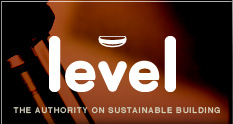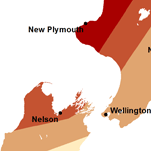- Home
- Site Analysis
- Site Use
- Passive Design
- Water
- Material Use
- Energy
- Wet Areas
- Health and Safety
- Other Resources
Site Analysis
Understanding all the features of a site, using and protecting the best, and minimising the impact of the worst.
Earthquake risk
New Zealand is divided into four earthquake risk zones for the purpose of determining the bracing requirements of buildings to resist earthquakes. Zone 1 represents areas of lowest risk and Zone 4 the highest risk.
Earthquakes can bring rapid, violent shaking both sideways and/or up and down, or slower rolling movements.
In some areas – especially hillsides – unstable ground may slide and rocks may fall.
On flat ground where there is a high water table and the soil is low-density sand or silt, liquefaction can take place. Liquid is forced to the surface, carrying sand and silt with it; land can slump; surface soil close to sloping ground (such as stream banks) can spread, with cracks opening up. Many local councils are investigating areas at risk of liquefaction and creating maps of these, including online maps that allow searches to be done for the risk to particular properties.
Depending on the location, earthquakes can bring other hazards such as tsunamis.
GNS Science maintains an interactive map of all known active faults in New Zealand.
New builds
There are strong rules around house construction to help houses better cope with earthquakes, and some of these rules were strengthened following the Canterbury earthquakes of 2010/2011. (In recent times, 187 people have died in New Zealand as a result of earthquake activity – 185 in Christchurch in 2011 and two in Kaikoura in 2016.)
Under NZS 3604:2011 Timber-framed buildings, bracing must be provided for all buildings, with greater bracing being required for buildings:
- in a higher earthquake zone
- where heavy roof and/or wall claddings are specified.
Earthquake bracing demand is covered in section 5.3 of NZS 3604:2011. The section includes maps showing earthquake zones 1–4.
Earthquake bracing is provided by lengths of wall where the cladding and/or lining works with the timber frame to form a bracing panel. NZS 3604 ensures an even distribution of bracing elements, so the building is not expected to twist significantly in an earthquake.
Nowadays, many light timber-framed buildings are not designed completely to NZS 3604 because homeowners want large windows on one side of the house to enjoy a view. This often requires special bracing elements designed by a structural engineer. The rest of the building can still be designed and constructed to the standard.
Simple houses constructed to NZS 3604 performed well in the Canterbury earthquakes, but houses with a mixed bracing system often had significant damage.
BRANZ conducted a research project funded by the Earthquake Commission around houses with mixed bracing systems. Based on the study, a simplified approach has been proposed for engineers to reduce the likelihood of significant earthquake damage where there is mixed bracing. You can read more about the BRANZ study here.
BRANZ research has also confirmed the effectiveness of simple retrofit solutions to strengthen foundations of existing houses on sloping hillsides.
Another key standard regarding earthquakes is NZS 1170.5:2004 Structural design actions – Part 5: Earthquake Actions – New Zealand.
An update to this standard, the technical specification TS 1170.5 Structural design actions - Part 5: Earthquake actions - New Zealand was released in early 2024. The new technical specification significantly increases requirements, including lifting design seismic loads for many locations and changing the way ground conditions are allowed for. TS 1170.5 will be published and available during a transition period as an alternative solution for demonstrating Building Code compliance. It will eventually become mandatory.
There are limits to how Building Code Acceptable Solutions can be used in some higher-risk locations. For example, Acceptable Solution B1/AS1 cannot be used for foundations on ground prone to liquefaction or lateral spreading. Buildings on this type of ground will have to use a Verification Method or Alternative Solution for building consent.
The National Seismic Hazard Model, which provides an estimate of the likelihood and strength of an earthquake at any given site, was updated and the update released in 2022. The likelihood of future earthquake shaking hazard is higher than the previous assessment throughout most of the country, ranging from almost no change to more than doubling in some areas. GNS Science says that “on average, results have increased by 50 percent or more from previous modelling, highlighting the need to boost national resilience strategies and readiness.”
Renovations
Depending on when and where a house was built, and what construction methods were used, there may be steps that can be taken to make it more resilient to earthquakes.
Houses with simple shapes and with timber frames and timber cladding tend to withstand earthquake shaking better, while unreinforced brick buildings are more likely to suffer damage.
Work that can be done to earthquake strengthen a house includes:
- Fixing or replacing damaged piles
- Making sure that piles are firmly fixed to bearers
- Adding timber braces between piles and bearers or joists, or between piles and corner foundations
- Adding new plasterboard lining over old sarking on interior walls
- Removing or replacing unreinforced masonry chimneys
- Making sure clay or concrete tiles are properly fixed
Removal of a building element such as an unsound chimney does not require a building consent (but the work must still meet Building Code requirements). This exemption is limited to any building up to 3 storeys high as long as the removal does not affect the primary structure, any specified system or any fire separation (which includes firewalls protecting other property). Remember to check roof sarking/framing which sometimes is supported on chimney structures. Be aware also that some bracing walls rely on support from chimneys either side.
Any repair work that is necessary – for example, makin/ roof after chimney removal – can also be done without a consent.
Consult a chartered professional engineer over what may be possible with unreinforced masonry walls.
EQC cover for earthquakes
New Zealand residential buildings that have a current house insurance policy that includes fire insurance are covered against natural disasters with EQ Cover. EQ Cover is provided by a government body, Toka Tū Ake EQC, and is government guaranteed. Within certain limitations, it insures against physical loss or damage resulting from a natural disaster.
The natural disasters that are covered are:
- earthquakes, natural landslips, volcanic eruptions, hydrothermal activity or tsunami
- fires caused by a natural disaster
- for residential land, storms or floods.
There is a 2-year time limit on lodging a claim. The cap on EQC residential building cover is $300,000 +GST. Homeowners can get top-up insurance from private insurers to cover loss above this limit.
On 30 June 2021, a new insurance claims process was introduced for claims after natural disasters such as earthquakes. Instead of having to deal with both EQC and their own insurance company, property owners just have to contact their insurance company, who will work with EQC on their behalf. Eight private insurers are part of the scheme.
The Natural Hazards Insurance Act, which became law in 2023, will make some changes to the EQC scheme. EQC will get a new name, Toka tū Ake/Natural Hazards Commission. This better reflects the broad range of hazards covered – earthquakes, landslips, volcanic activity, tsunami, hydrothermal activity, flood, storm or a fire caused by a natural hazard. (For a storm or flood, natural hazard damage only covers damage to land.)
Updated: 25 February 2024


